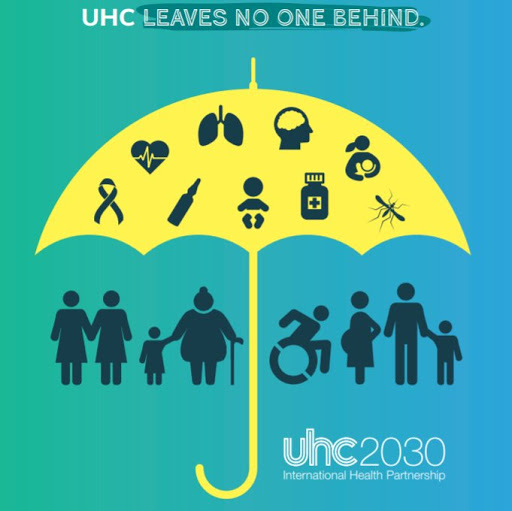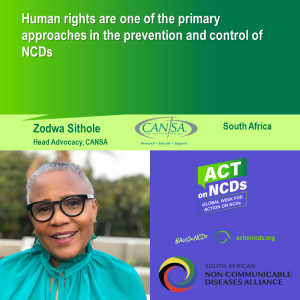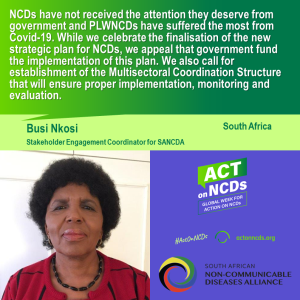
This Global Week for Action on NCDs (6 – 12 September 2021), the South African Non-Communicable Diseases Alliance (SANCDA), of which the Cancer Association of South Africa (CANSA) is a founding partner, celebrate the progress made in raising the profile of people living with non-communicable diseases (NCDs) in SA. Together with other civil society members, the Global Week of Action on NCDs hails the power and potential of people to act together on and drive NCDs change. The aim is to ensure that commitments made by government to improve health for people living with NCDs, will become a reality. The challenges presented by COVID-19 will not compromise action to help relieve the NCDs burden.
#ActOnNCDs #NCDvoices
 Dr Vicki Pinkney-Atkinson, Director of the SANCDA says, “In SA, the people’s NCDs movement struggles to make the government recognise and meaningfully involve diverse groups, including people living with NCDs to reduce the NCDs burden. Government and other stakeholders committed to global targets to prevent and control NCDs and improve the health of the nation. Now we need to these commitments translate into meeting the UN Sustainable Development Goals.”
Dr Vicki Pinkney-Atkinson, Director of the SANCDA says, “In SA, the people’s NCDs movement struggles to make the government recognise and meaningfully involve diverse groups, including people living with NCDs to reduce the NCDs burden. Government and other stakeholders committed to global targets to prevent and control NCDs and improve the health of the nation. Now we need to these commitments translate into meeting the UN Sustainable Development Goals.”
Many NCDs are preventable, yet they remain the number one cause of death and disability globally and in SA. Diabetes is still the leading cause of death in SA women. NCDs are mainly driven by five preventable risk factors: tobacco use, unhealthy diet, physical inactivity, harmful use of alcohol and air pollution. Weak health systems, under-investment and lack of accountability by government contributes to increasing the NCDs burden. NCDs include health conditions which usually don’t spread from person to person. Examples are cancers, diabetes and cardiovascular diseases (such as heart attacks and stroke), chronic respiratory diseases (such as chronic obstructive pulmonary disease and asthma) and mental health conditions.
“If every person exercises the right to participate in decision making about their health we would have more accountability for NCDs prevention and care. The SANCDA and our many partners urge the people, including those living with NCDs, to join us in our quest to accelerate action on NCDs. Together we will hold the authorities to account for meeting our needs. What we demand is understanding community needs better, helping to identify gaps, developing options in response to challenges, understand the impact of decisions on different people, and balance input, perspectives and interests,” adds Pinkney-Atkinson, herself living with more than 20 NCDs.
By working together, civil society and the SANCDA highlights the actions undertaken to close the NCDs gap. Achievements include:
- Teaming up with the Dullah Omar Institute with its expertise in constitutional law and human rights to explore how law and treaties advance the NCDs agenda. Legal measures against government for its failure to meet commitments to rights and equity are part of this.
- Working with the National Department of Health to craft the national NCDs policy (due for publication soon).
- Joining forces with local and global social movements representing people left behind, including those focussed on stigmatised NCDs conditions like disability, mental health and obesity.
- Coordinating consistent civil society policy action across all Sustainable Development Goals (SDGs) linked to NCDs prevention and control such as poverty, hunger, and emergency-disaster preparedness and responses to COVID-19.
- Calls for inclusive NCD governance mechanisms to secure the role of people living with NCDs and civil society in health policy at national, regional and international levels, since 2013. SANCDA endorses the Global Charter on Meaningful Involvement of People Living with NCDs. As a tool this will ensure meaningful involvement and transparency.
- Consistently communicating by leveraging outrage, rebuking injustice, translating evidence, sharing personal stories, celebrating successes, and campaigning collaboratively for the annual Global Week of Action on NCDs and other milestone days, weeks and political campaigns. It includes using traditional social media to make noise, demand change, and put issues, insights, and possible solutions in front of policymakers based on human rights and dignity..
Pinkney-Atkinson states, “During COVID-19, we experienced the devastating effects of neglect of NCDs and failure to invest in our health systems. Role players can prevent a repetition of this and can help close gaps and deliver progress on NCDs.”
#ActOnNCDs through social media
People affected by NCDs can be a voice of change by sharing their own messages of support by going to the Global Week for Action on NCDs Map of Impact on https://actonncds.org/take-action/be-a-voice-change . The Voices of Change online picture generator will quickly and easily upload a message and picture and share it on social media.
The SANCDA encourages all to get involved and share messages of support on social media platforms using the hashtags: #ActOnNCDs #NCDvoices. Or mobilise action and be an agent of change – https://actonncds.org/take-action/go-extra-mile
(For more information, please contact Vicki Pinkney-Atkinson, Director SANCDA email: [email protected] or mobile +27-83-38-38-159
Or
Lucy Balona, Head: Marketing and Communication at CANSA at email [email protected]. Call 011 616 7662 or mobile 082 459 5230.

A first draft of the WHO integrated global action plan (GAP) on epilepsy and neurological disorders is available for comment by 5 August 2021. Click here. Use the web-based consultation form to make comments or send comments to [email protected]
Background
The World Health Assembly (73rd session, 2020) endorsed a resolution on Global actions on epilepsy and other neurological disorders (WHA 73.10), requesting WHO Director-General to develop an intersectoral GAP in consultation with Member States. The GAP must address the existing worldwide challenges and gaps in providing care and services for people with neurological disorders and ensure a comprehensive, coordinated response across sectors.
In March 2021 WHO published a discussion paper on the intersectoral GAP on epilepsy and other neurological disorders. Member States, UN agencies and relevant non-state actors have shared comments via virtual and web-based consultations.
The first draft of the intersectoral GAP on epilepsy and other neurological disorders developed based on the inputs received, outlines the scope, vision, goal, and strategic objectives as well as specific actions for certain stakeholders.

 On 20 July 2021, the SA NCDs Alliance is co-hosting and coordinating a people’s consultation on universal health coverage (UHC). This is especially for you if you use government health services.
On 20 July 2021, the SA NCDs Alliance is co-hosting and coordinating a people’s consultation on universal health coverage (UHC). This is especially for you if you use government health services.
The South African version of UHC is called “national health insurance” or NHI. But are we talking about the same thing? There are some big differences. What do you think?
The event is a virtual focus group lasting 2 hours with 30 participants. You can only participate if you apply. We want to hear your voice especially if you are part of a vulnerable or hard-to-reach group that uses public or government health services. So you need to complete that application form and showing us why your participation is important.
Apply to join the conversation here
- People who are left behind or have trouble having their health needs met before or during COVID-19?
- Civil society participants, breakout group facilitators or note-takers.
We want to make sure that we hear from you, the people, and especially if you are in that “seldom heard” and vulnerable group. We can help a few selected participants with data package to participate on the day.
The event forms part of the United Nations Civil Society Engagement Mechanism (CSEM) for UHC2030 efforts to gather South African insights on the state of UHC. Your views will be inputted into the UN State of the UHC Commitment Report for publication at the end of 2021 (around UHC Day 12 Dec). Here is the 2020 State of the UHC Commitment Report.
An excellent and relevant reference just published by WHO is Voice, agency, empowerment: Handbook on social participation for UHC 2021
A Stats SA report has revealed that TB remains the main leading cause of death in South Africa between 2016 and 2018.
The report, titled “Mortality and causes of death in South Africa: Findings from death notification, 2018”, provides information on levels, trends and patterns in mortality and cause-of-death statistics by socio-demographic and geographic characteristics.
“The mortality indicators and cause of death indicators presented in this report are critical indicators on the health status of the South African population,” said Stats SA.
“The main focus is on 2018 death occurrences; however, information on deaths that occurred during the period 1997 to 2017 is included in order to show trends in mortality. The cause-of-death statistics in this statistical release provide information on the leading underlying natural causes of death, patterns and trends in non-natural underlying causes of deaths, as well as comparison between immediate, contributing and underlying causes of death,” said Stats SA on Tuesday.
According to the report, mortality levels are declining in the country as indicated by the downward trend in the number of registered deaths since 2007.
The results showed that the total number of deaths registered at the Department of Home Affairs and processed by Stats SA in 2018 were 454 014.
While the occurrence of deaths in the country continued to decline, it differed by age and sex. The age group 65-69 had the highest proportion of deaths in 2018 at 8.4%, followed closely by age group 60-64 at 8.3%. Conversely, the lowest proportions of deaths were observed in age groups 5-9 years and 10-14 years at 0.6 % and 0.8%, respectively.
With regard to sex, between 1997 and 2018, there were more male than female deaths from age 0 to age group 65-69; whereas female deaths consistently exceeded male deaths for ages 70 years and above.
The results further indicate that in 2018, the highest sex ratio (167 male deaths per 100 female deaths) was observed in the age group 20-24 years. The pattern was observed for four consecutive years, between 2015 and 2018.
For the period 2016-2018, Tuberculosis remained the main leading cause of death in South Africa.
Diabetes mellitus, the report found, remained as the second leading underlying cause of death whose proportions have been increasing over the three years.
“According to the global burden of diseases, two of the top five leading underlying causes of death for males were communicable diseases (tuberculosis and HIV) whilst among females, there was only one communicable disease (HIV) with the rest being non-communicable diseases.
Stats SA said the results showed that 9 out of 10 leading causes of death were the same for both sexes, although with different rankings.
“Tuberculosis was the leading underlying cause of death for males, accounting for 7.2% of male deaths while diabetes mellitus was the leading underlying cause of death amongst females accounting for 7.7% of female deaths.
“Human immunodeficiency virus [HIV] disease (4.6%) was the second leading cause of death for the males, followed by other forms of heart disease (4.5%). Cerebrovascular diseases (6.1%) was the second leading underlying cause of death for females.
“In 2018, the most significant decline amongst females were deaths due to tuberculosis which declined from 5.2% in 2016 to 4.8% in 2018. Uniform to this, there was a significant decline in tuberculosis deaths from 7.2% in 2015 to 7.6% in 2018 among males.
Non-natural deaths
Stats SA said although the number of deaths due to natural causes were higher than the number of deaths due to non-natural causes, the proportion of deaths due to non-natural cause have been on a slight increase in the recent years.
Between 2010 and 2018, a consistent increase in the proportions of deaths due to non-natural causes was noted from 9.0% in 2010 to 11.9% in 2018. The age groups mostly affected by non-natural causes of death in 2018 were age group 20-24 years and 15-19, accounting for 49.2% and 42.5%, respectively.
Males had higher proportions of deaths due to non-natural causes compared to females, with a wider difference observed at age group 15-29 where as much as 58,1% of male deaths resulted from non-natural causes compared to 19,8% of female deaths in the same age group.
Deaths due to non-natural causes were mainly dominated by those due to other external causes of accidental injury (68.3%) followed by assault (14.0%) whilst there were 11.4% non-natural deaths due to transport accidents.
In total, KwaZulu-Natal had the highest proportion of deaths due to non-natural causes (13.5%), followed closely by Cape Town (13.0%). In terms of proportions, deaths due to transport accidents were the highest in Limpopo (30.1%), whilst assault was highest in Eastern Cape (22.7%).

The South African Non-Communicable Disease Alliance (SANCDA) will host the 3rd Happy Hour Xchange on Thursday, 22 April 2021 at 18:00 focussing on ‘Disability, Down Syndrome and COVID-19.
Join Dr Vicki for her Xchange with Ancella Ramjas (National Executive Director: Down Syndrome SA) for part 1: Downright disastrous COVID-19 response for persons with Down Syndrome? And part 2: Missing the point of vaccinations.
Registration for the NCD Happy Hour Xchange is essential. Limited space is available.
Register for the NCD Happy Hour Xchange
#NCDsHappyHourXchange #SANCDA
 People living with NCDs are at a higher risk of becoming severely ill if they contract COVID-19. NCDs are underlying health conditions that require you to take special care: cardiovascular diseases, diabetes, chronic respiratory diseases, obesity, dementia, kidney disease and cancer.
People living with NCDs are at a higher risk of becoming severely ill if they contract COVID-19. NCDs are underlying health conditions that require you to take special care: cardiovascular diseases, diabetes, chronic respiratory diseases, obesity, dementia, kidney disease and cancer.
NCDs and other chronic conditions can make the immune system slow down and making it easier to get an infection like COVID-19. So, we want to keep you healthy.
The SANCDA, founded in 2013, brings together trusted South African organisations and together we have 200 years of service for people living with NCDs. We work with civil society organisations and individuals to focus on NCDs policy and implementation in South Africa. We want public policy that is transparent and responsive to all of our health needs and the conditions we face. Our partners support the upfront disclosure and transparency of funding arrangements for stakeholders and partners. Our funding is received from philanthropic groups and supported by the global NCD Alliance.
Contact Dr Vicki Pinkney-Atkinson, Director of SANCDA on 083 383 8159 or email: [email protected] for more information or visit https://www.sancda.org.za/
NCDs Happy Hour Xchange is funded by a NCD Alliance’s 2020 Act on NCDs Campaign Fuel Award, part of NCD Alliance’s partnership with Access Accelerated.

 Dr Vicki Pinkney-Atkinson, Director of the SANCDA says, “In SA, the people’s NCDs movement struggles to make the government recognise and meaningfully involve diverse groups, including people living with NCDs to reduce the NCDs burden. Government and other stakeholders committed to global targets to prevent and control NCDs and improve the health of the nation. Now we need to these commitments translate into meeting the UN Sustainable Development Goals.”
Dr Vicki Pinkney-Atkinson, Director of the SANCDA says, “In SA, the people’s NCDs movement struggles to make the government recognise and meaningfully involve diverse groups, including people living with NCDs to reduce the NCDs burden. Government and other stakeholders committed to global targets to prevent and control NCDs and improve the health of the nation. Now we need to these commitments translate into meeting the UN Sustainable Development Goals.”









 People living with NCDs are at a higher risk of becoming severely ill if they contract COVID-19. NCDs are underlying health conditions that require you to take special care: cardiovascular diseases, diabetes, chronic respiratory diseases, obesity, dementia, kidney disease and cancer.
People living with NCDs are at a higher risk of becoming severely ill if they contract COVID-19. NCDs are underlying health conditions that require you to take special care: cardiovascular diseases, diabetes, chronic respiratory diseases, obesity, dementia, kidney disease and cancer.